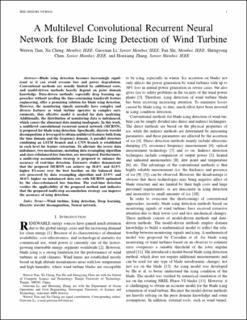| dc.contributor.author | Tian, Weiwei | |
| dc.contributor.author | Cheng, Xu | |
| dc.contributor.author | Li, Guoyuan | |
| dc.contributor.author | Shi, Fan | |
| dc.contributor.author | Chen, Shengyong | |
| dc.contributor.author | Zhang, Houxiang | |
| dc.date.accessioned | 2021-10-27T09:01:27Z | |
| dc.date.available | 2021-10-27T09:01:27Z | |
| dc.date.created | 2021-07-02T09:47:30Z | |
| dc.date.issued | 2021 | |
| dc.identifier.issn | 1530-437X | |
| dc.identifier.uri | https://hdl.handle.net/11250/2825906 | |
| dc.description.abstract | Blade icing detection becomes increasingly significant as it can avoid revenue loss and power degradation. Conventional methods are usually limited by additional costs, and model-driven methods heavily depend on prior domain knowledge. Data-driven methods, especially deep learning approaches without needing the time-consuming handcraft feature engineering, offer a promising solution for blade icing detection. However, the monitoring signals normally have complex and diverse features as wind turbine operates in complex environments, thus effective model is needed for data analyzing. Additionally, the distribution of monitoring data is imbalanced, which causes the abnormal data mining inadequate. In this work, a multilevel convolutional recurrent neural network (MCRNN), is proposed for blade icing detection. Specifically, discrete wavelet decomposition is leveraged to obtain multilevel features both from the time domain and the frequency domain. A parallel structure combining an LSTM branch and a CNN branch is established in each level for feature extraction. To alleviate the severe data imbalance, two mechanisms, including data resampling algorithm and class-rebalanced loss function, are investigated. Furthermore, a multi-step accumulation strategy is proposed to enhance the accuracy of real-time detection. Extensive studies demonstrate that the proposed MCRNN can achieve up 38.8% and 42.9% higher F1-score over the best baseline on the balanced data sets processed by data resampling algorithm and 23.9% and 30.6% higher on imbalanced data sets with MCRNN optimized by the class-rebalanced loss function. The real-time detection verifies the applicability of the proposed method and indicates that the proposed multi-step accumulation strategy can improve the accuracy of icing detection. | en_US |
| dc.language.iso | eng | en_US |
| dc.publisher | Institute of Electrical and Electronics Engineers (IEEE) | en_US |
| dc.title | A Multilevel Convolutional Recurrent Neural Network for Blade Icing Detection of Wind Turbine | en_US |
| dc.type | Peer reviewed | en_US |
| dc.type | Journal article | en_US |
| dc.description.version | acceptedVersion | en_US |
| dc.rights.holder | © IEEE. Personal use of this material is permitted. Permission from IEEE must be obtained for all other uses, in any current or future media, including reprinting/republishing this material for advertising or promotional purposes, creating new collective works, for resale or redistribution to servers or lists, or reuse of any copyrighted component of this work in other works. | en_US |
| dc.source.journal | IEEE Sensors Journal | en_US |
| dc.identifier.doi | 10.1109/JSEN.2021.3093726 | |
| dc.identifier.cristin | 1919982 | |
| cristin.ispublished | true | |
| cristin.fulltext | postprint | |
| cristin.qualitycode | 2 | |
